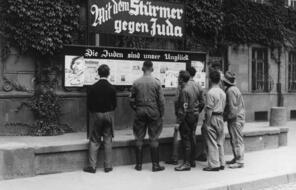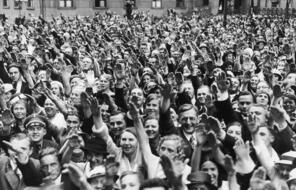The Impact of Nazi Propaganda: Visual Essay
At a Glance
Language
English — USSubject
- History
- The Holocaust
- Propaganda
Propaganda was one of the most important tools the Nazis used to shape the beliefs and attitudes of the German public. Through posters, film, radio, museum exhibits, and other media, they bombarded the German public with messages designed to build support for and gain acceptance of their vision for the future of Germany. The gallery of images below exhibits several examples of Nazi propaganda, and the introduction that follows explores the history of propaganda and how the Nazis sought to use it to further their goals.
Examples of Nazi Propaganda
Nazi National Welfare Program
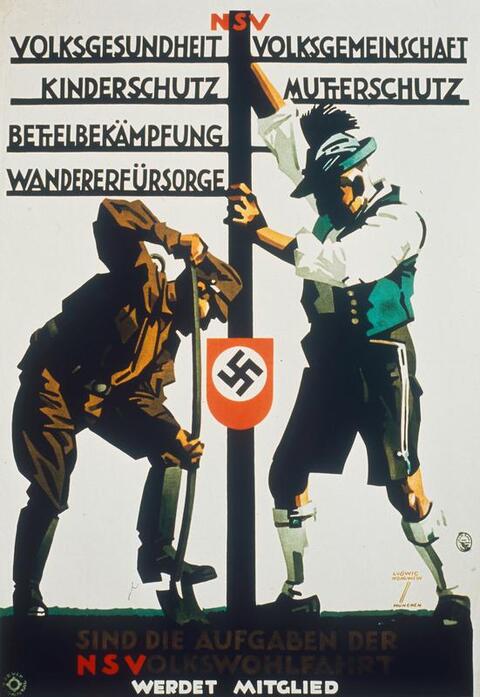
Nazi National Welfare Program
This 1934 propaganda poster in support of the national welfare program reads: “National health, national community, child protection, protection of mothers, care for travelers, are the tasks of the NS-Welfare Service. Join now!”
Nazi Recruitment Propaganda
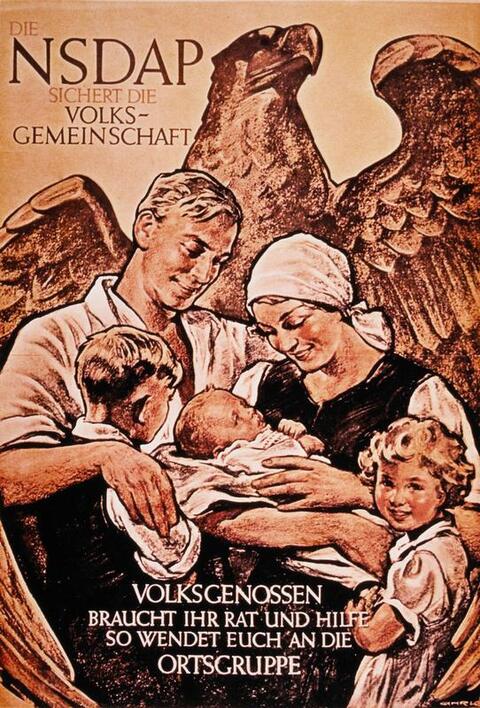
Nazi Recruitment Propaganda
This mid-1930s poster says, “The NSDAP [Nazi Party] protects the people. Your fellow comrades need your advice and help, so join the local party organization.
Hitler Youth Propaganda
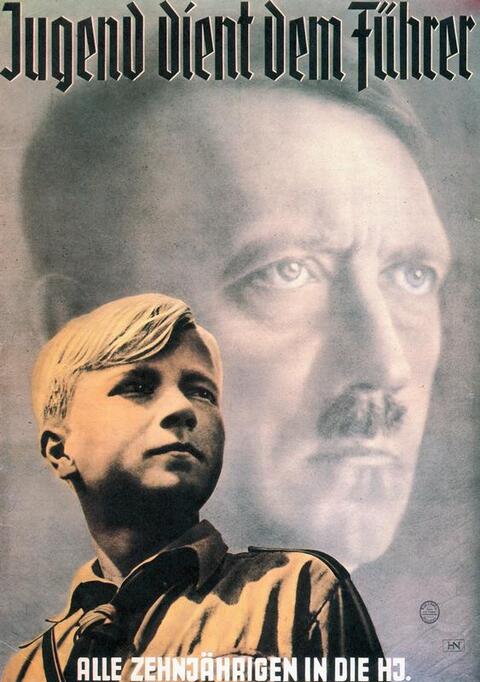
Hitler Youth Propaganda
This 1935 poster promotes the Hitler Youth by stating: “Youth serves the Führer! All ten-year-olds into the Hitler Youth.”
Nazi Propaganda Newspaper
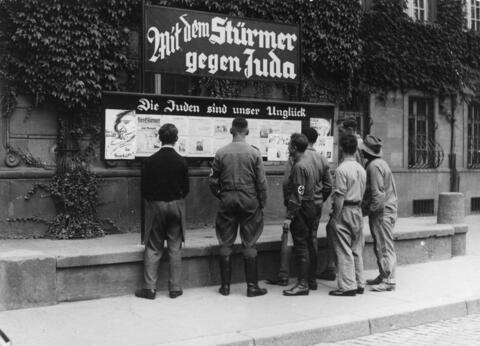
Nazi Propaganda Newspaper
An issue of the antisemitic propaganda newspaper Der Stürmer (The Attacker) is posted on the sidewalk in Worms, Germany, in 1935. The headline above the case says, "The Jews Are Our Misfortune."
Triumph of the Will Propaganda Film
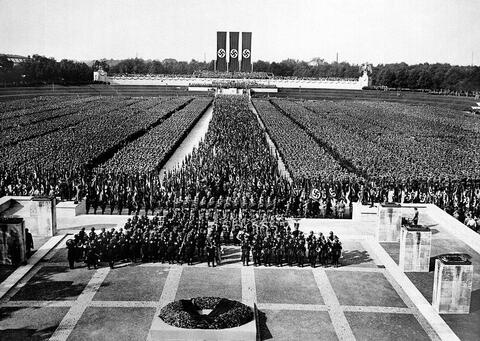
Triumph of the Will Propaganda Film
Leni Riefenstahl's documentary-style film glorified Hitler and the Nazi Party. It was shot at the 1934 Nazi Party congress and rally in Nuremberg.
Propaganda Portrait of Hitler
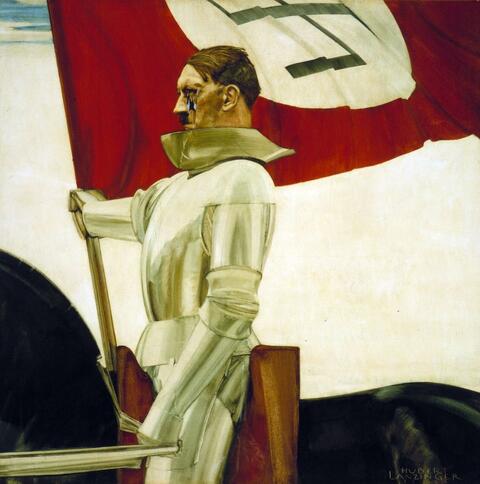
Propaganda Portrait of Hitler
This portrait, The Standard Bearer, was painted by artist Hubert Lanzinger and displayed in the Great German Art Exhibition in Munich in 1937.
The Eternal Jew
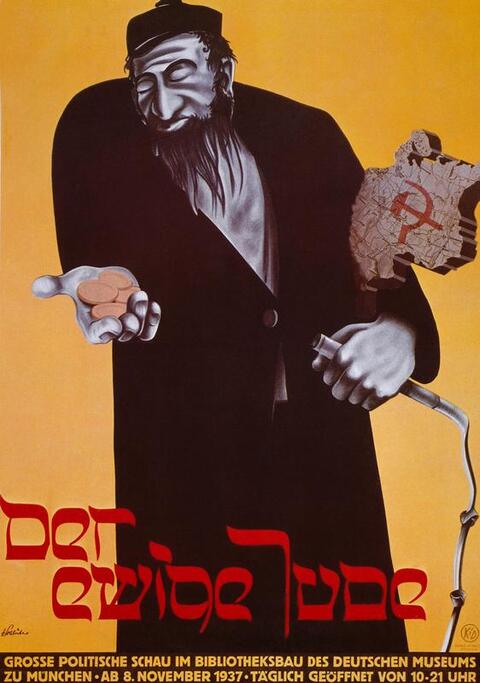
The Eternal Jew
This 1938 poster advertises a popular antisemitic traveling exhibit called Der Ewige Jude (The Eternal Jew).
Antisemitic Display at Der Ewige Jude
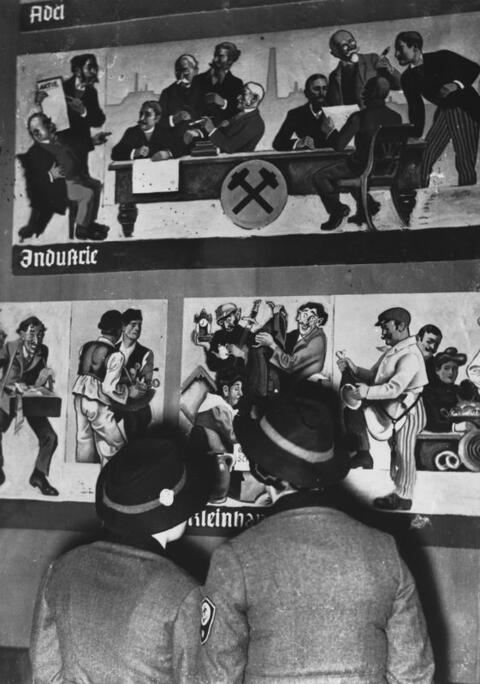
Antisemitic Display at Der Ewige Jude
Women examining a display at the Der Ewige Jude (The Eternal Jew) exhibition in the Reichstag building in November 1938.
Antisemitic Children's Book
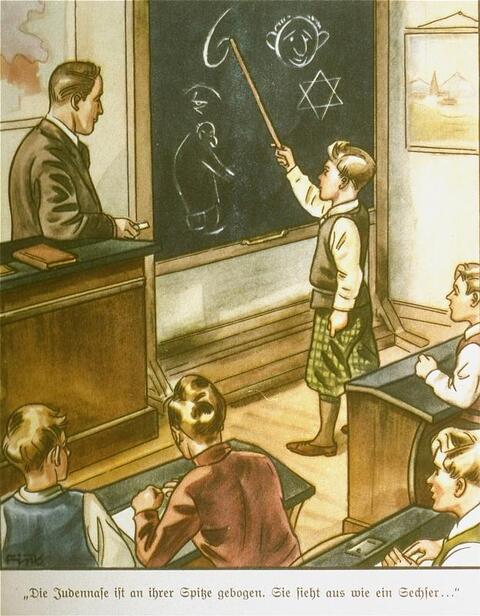
Antisemitic Children's Book
From the 1938 antisemitic children’s book The Poisonous Mushroom. The boy is drawing a nose on the chalkboard, and the caption reads: “The Jewish nose is crooked at its tip. It looks like a 6.”
The Definition and History of Propaganda
Propaganda is information that is intended to persuade an audience to accept a particular idea or cause, often by using biased material or by stirring up emotions. This was one of the most powerful tools the Nazis used to consolidate their power and create a German “national community” in the mid-1930s.
Hitler and Goebbels did not invent propaganda. The word itself was coined by the Catholic Church to describe its efforts to discredit Protestant teachings in the 1600s. Over the years, almost every nation has used propaganda to unite its people in wartime. Both sides spread propaganda during World War I, for example.
How the Nazis Used Propaganda
The Nazis were notable for making propaganda a key element of government even before Germany went to war again. One of Hitler’s first acts as chancellor was to establish the Reich Ministry of Public Enlightenment and Propaganda, demonstrating his belief that controlling information was as important as controlling the military and the economy. He appointed Joseph Goebbels as director. Through the ministry, Goebbels was able to penetrate virtually every form of German media, from newspapers, film, radio, posters, and rallies to museum exhibits and school textbooks, with Nazi propaganda.
Whether or not propaganda was truthful or tasteful was irrelevant to the Nazis. Goebbels wrote in his diary, "no one can say your propaganda is too rough, too mean; these are not criteria by which it may be characterized. It ought not be decent nor ought it be gentle or soft or humble; it ought to lead to success." 1 Hitler wrote in Mein Kampf that to achieve its purpose, propaganda must "be limited to a very few points and must harp on these in slogans until the last member of the public understands what you want him to understand by your slogan. As soon as you sacrifice this slogan and try to be many-sided, the effect will piddle away."
Some Nazi propaganda used positive images to glorify the government’s leaders and its various activities, projecting a glowing vision of the “national community.” Nazi propaganda could also be ugly and negative, creating fear and loathing by portraying the regime’s “enemies” as dangerous and even sub-human. The Nazis’ distribution of antisemitic films, newspaper cartoons, and even children’s books aroused centuries-old prejudices against Jews and also presented new ideas about the racial impurity of Jews. The newspaper Der Stürmer (The Attacker), published by Nazi Party member Julius Streicher, was a key outlet for antisemitic propaganda.
This visual essay includes a selection of Nazi propaganda images, both “positive” and “negative.” It focuses on posters that Germans would have seen in newspapers like Der Stürmer and passed in the streets, in workplaces, and in schools. Some of these posters were advertisements for traveling exhibits—on topics like “The Eternal Jew” or the evils of communism—that were themselves examples of propaganda.
Connection Questions
- As you explore the images in this visual essay, consider what each image is trying to communicate to the viewer. Who is the audience for this message? How is the message conveyed?
- Do you notice any themes or patterns in this group of propaganda images? How do the ideas in these images connect to what you have already learned about Nazi ideology? How do they extend your thinking about Nazi ideas?
- Based on the images you analyze, how do you think the Nazis used propaganda to define the identities of individuals and groups? What groups and individuals did Nazi propaganda glorify? What stereotypes did it promote?
- Why was propaganda so important to Nazi leadership? How do you think Nazi propaganda influenced the attitudes and actions of Germans in the 1930s?
- Some scholars caution that there are limits to the power of propaganda; they think it succeeds not because it persuades the public to believe an entirely new set of ideas but because it expresses beliefs people already hold. Scholar Daniel Goldhagen writes: “No man, [no] Hitler, no matter how powerful he is, can move people against their hopes and desires. Hitler, as powerful a figure as he was, as charismatic as he was, could never have accomplished this [the Holocaust] had there not been tens of thousands, indeed hundreds of thousands of ordinary Germans who were willing to help him.” 2 Do you agree? Would people have rejected Nazi propaganda if they did not already share, to some extent, the beliefs it communicated?
- Can you think of examples of propaganda in society today? How do you think this propaganda influences the attitudes and actions of people today? Is there a difference between the impact of propaganda in a democracy that has a free press and an open marketplace of ideas and the impact of propaganda in a dictatorship with fewer non-governmental sources of information?
How to Cite This Reading
Facing History & Ourselves, "Visual Essay: The Impact of Propaganda," last updated August 2, 2016.

